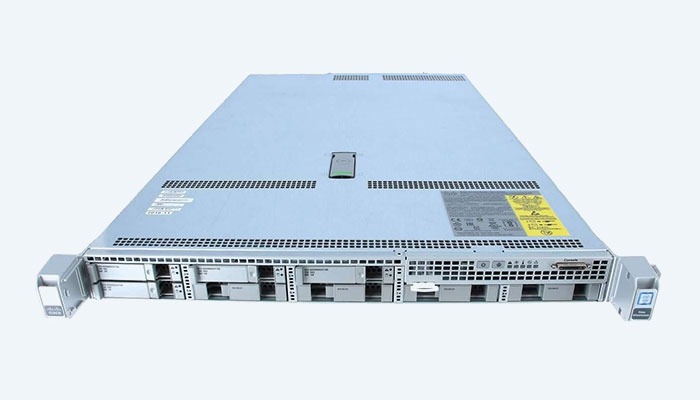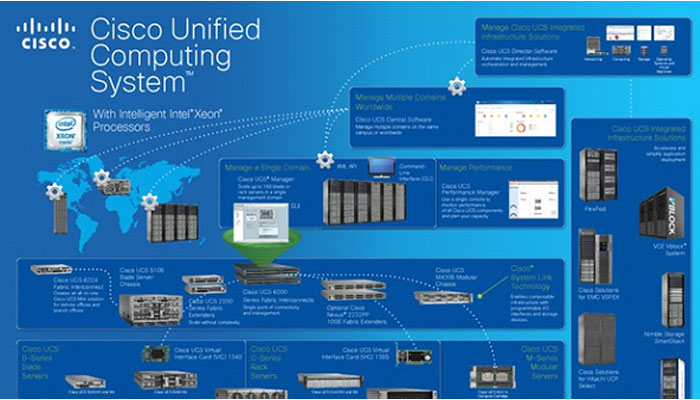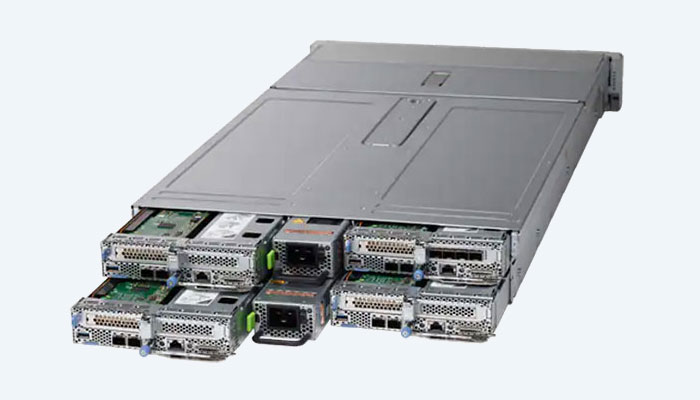UCS
Home » Cisco License » Networking » UCS
The licensed Cisco UCS, or Unified Computing System, is a data center platform that combines computing, networking, storage, and virtualization resources into a single cohesive system. It was first introduced by Cisco Systems in 2009 as a way to simplify data center management and improve performance and efficiency.
At its core, Cisco UCS consists of two main components: servers and fabric interconnects. The servers are designed to provide high-performance computing resources, while the fabric interconnects serve as the central point of management for the entire system.
One of the key benefits of Cisco UCS is its ability to provide a unified, programmable infrastructure that can be easily managed using a single interface. This makes it easier for IT teams to deploy and manage resources, while also providing greater flexibility and scalability.
The Key Components of Cisco UCS: Servers, Fabric Interconnects, and More
Let’s take a closer look at the key components of Cisco UCS:
- Servers: Cisco UCS servers are designed to provide high-performance computing resources for a variety of workloads, including virtualization, big data, and more. They are available in a range of form factors, from blade servers to rack servers, and can be easily scaled and configured to meet the needs of any organization.
- Fabric Interconnects: The fabric interconnects serve as the central point of management for the entire UCS system. They provide connectivity to the servers, as well as to the external network and storage resources. The fabric interconnects are highly programmable, which allows IT teams to automate many of the tasks associated with managing the data center.
- Fabric Extenders: Fabric extenders, or FEXes, are used to extend the fabric interconnects to the servers. They are essentially remote line cards that can be deployed in the same rack as the servers, or in a separate rack altogether. This allows for greater flexibility in the deployment of UCS resources.
- UCS Manager: UCS Manager is the central management interface for the entire UCS system. It provides a single point of control for all of the servers, fabric interconnects, and other components in the data center. This makes it easier for IT teams to deploy, manage, and troubleshoot the system.
How Cisco UCS Optimizes Data Center Performance and Efficiency
One of the main benefits of Cisco UCS is its ability to optimize data center performance and efficiency. Here are some of the ways that it does this:
Unified Infrastructure: By combining computing, networking, storage, and virtualization resources into a single system, Cisco UCS eliminates many of the traditional silos that exist in data center infrastructure. This allows for greater efficiency, as resources can be shared and utilized more effectively.
Programmability: Cisco UCS is highly programmable, which allows IT teams to automate many of the tasks associated with managing the data center. This reduces the risk of human error and frees up IT staff to focus on more strategic initiatives.
High-Performance Computing: Cisco UCS servers are designed to provide high-performance computing resources for a variety of workloads. This allows organizations to run demanding applications and workloads without sacrificing performance or efficiency.
Scalability: Cisco UCS is designed to be highly scalable, which means that organizations can easily add or remove resources as needed. This makes it easier to adapt to changing business needs and ensures that the data center is always optimized for performance and efficiency.
Exploring the Benefits of Cisco UCS for Enterprise IT Infrastructure
So, what are the specific benefits of Cisco UCS for enterprise IT infrastructure? Here are some of the key advantages:
Simplified Management: By providing a unified infrastructure and a single point of management, Cisco UCS simplifies data center management and administration. This reduces the risk of errors and makes it easier for IT teams to deploy and manage resources.
Greater Flexibility: The licensed Cisco UCS is designed to be highly flexible, which allows organizations to easily adapt to changing business needs. This makes it easier to scale resources up or down as needed, and to deploy new applications and workloads quickly and easily.
Improved Performance: Cisco UCS servers are designed to provide high-performance computing resources, which allows organizations to run demanding applications and workloads without sacrificing performance or efficiency.
Lower TCO: By simplifying data center management and improving efficiency, Cisco UCS can help organizations reduce their total cost of ownership (TCO) for IT infrastructure. This can lead to significant cost savings over time.
How Cisco UCS Simplifies Management and Administration of Data Center Operations
One of the key benefits of Cisco UCS is its ability to simplify data center management and administration. Here are some of the ways that it does this:
Single Point of Management: With UCS Manager, IT teams can manage the entire data center from a single interface. This eliminates the need for multiple management tools and reduces the risk of errors.
Automation: The licensed Cisco UCSis highly programmable, which allows IT teams to automate many of the tasks associated with managing the data center. This includes tasks such as server provisioning, firmware updates, and network configuration. By automating these tasks, IT teams can reduce the risk of human error and free up staff to focus on more strategic initiatives.
Role-Based Access Control: Cisco UCS includes role-based access control (RBAC), which allows IT teams to define granular access controls for different users and user groups. This ensures that only authorized personnel have access to sensitive data and resources.
Service Profiles: Cisco UCS uses service profiles to quickly and easily provision new servers. Service profiles contain all of the configuration information needed to deploy a new server, including firmware settings, network configurations, and storage information. This makes it easy to deploy new servers quickly and consistently.
Cisco UCS vs. Traditional Server Infrastructure
How does Cisco UCS compare to traditional server infrastructure? Here are some of the key differences:
- Integrated Infrastructure: Cisco UCS is designed as an integrated infrastructure, which means that computing, networking, storage, and virtualization resources are combined into a single system. Traditional server infrastructure typically consists of separate components that must be managed separately.
- Programmability: Cisco UCS is highly programmable, which allows IT teams to automate many of the tasks associated with managing the data center. Traditional server infrastructure typically requires manual management and configuration.
- Scalability: Cisco UCS is designed to be highly scalable, which means that organizations can easily add or remove resources as needed. Traditional server infrastructure may be more difficult to scale, particularly if it consists of separate components that must be managed separately.
- Management: The licensed Cisco UCS provides a single point of management for the entire data center, while traditional server infrastructure may require multiple management tools and interfaces.
Understanding Cisco UCS Use Cases, Virtualization, Big Data, and More
Cisco UCS can be used for a variety of different workloads and use cases. Here are some of the most common:
- Virtualization: Cisco UCS is well-suited for virtualization workloads. The high-performance computing resources and integrated infrastructure make it easy to deploy and manage virtual machines.
- Big Data: Cisco UCS can be used for big data workloads, such as Hadoop and Spark. The high-performance computing resources and scalable infrastructure make it well-suited for processing large datasets.
- Private Cloud: Cisco UCS can be used to build a private cloud infrastructure. The integrated infrastructure and programmability make it easy to automate many of the tasks associated with managing a private cloud.
- High-Performance Computing: Cisco UCS is designed to provide high-performance computing resources, which makes it well-suited for scientific and technical computing workloads.
The Future of Cisco UCS: Trends and Innovations to Watch
As technology continues to evolve, what does the future hold for Cisco UCS? Here are some trends and innovations to watch:
Artificial Intelligence: As AI continues to become more widespread, there may be opportunities for Cisco UCS to be used for AI workloads. The high-performance computing resources and programmable infrastructure could be well-suited for these types of workloads.
Edge Computing: As more devices become connected to the internet, there may be a greater need for edge computing infrastructure. Cisco UCS could be used to build edge computing infrastructure that is both scalable and efficient.
Hybrid Cloud: As organizations continue to adopt hybrid cloud strategies, there may be opportunities for Cisco UCS to be used as a bridge between private and public cloud infrastructure.
How to Get Started with Cisco UCS, Implementation and Best Practices
If you’re interested in implementing Cisco UCS, here are some best practices to keep in mind:
- Plan Carefully: Before implementing Cisco UCS, it’s important to carefully plan your deployment. This includes understanding your workload requirements, selecting the appropriate server form factor, and ensuring that your network and storage infrastructure can support the deployment.
- Use Service Profiles: Service profiles can help you quickly and easily provision new servers. By using service profiles, you can ensure that new servers are deployed consistently and in accordance with best practices.
- Implement RBAC: Role-based access control is an important security feature of Cisco UCS. Implementing RBAC can help you ensure that only authorized personnel have access to sensitive data and resources.
In conclusion, Cisco UCS is a powerful and versatile data center platform that can help organizations improve the performance and efficiency of their IT infrastructure. By combining computing, networking, storage, and virtualization resources into a single cohesive system, Cisco UCS provides a unified infrastructure that is easy to manage and highly scalable. Whether you’re looking to support virtualization workloads, big data processing, or scientific computing, Cisco UCS can help you achieve your goals while reducing costs and simplifying management.
| Product name | Product description | Product price | Discount | Product display |
|---|---|---|---|---|
| L-FTDE140N-TMC-5Y | Cisco NGFWv IPS, Apps, AMP and URL on UCS-E140N 5Y Svc Sub | $8,000.00 | No | Product display |
| L-FTDUCSE-TMC-1Y | Cisco NGFWv IPS, Apps, AMP and URL on UCS-E 1Y Svc Sub | $8,500.00 | No | Product display |
| L-FTDUCSE-TMC-3Y | Cisco NGFWv IPS, Apps, AMP and URL on UCS-E 3Y Svc Sub | $20,400.00 | No | Product display |
| L-FTDUCSE-TMC-5Y | Cisco NGFWv IPS, Apps, AMP and URL on UCS-E 5Y Svc Sub | $34,000.00 | No | Product display |
| L-FTD4451A-TMC-3Y | Cisco NGFWv IPS, Apps, AMP and URL on 4451-120 3Y Svc Sub | $16,800.00 | No | Product display |
| L-FTDE140N-TMC-1Y | Cisco NGFWv IPS, Apps, AMP and URL on UCS-E140N 1Y Svc Sub | $2,000.00 | No | Product display |
| L-FTDE140N-TMC-3Y | Cisco NGFWv IPS, Apps, AMP and URL on UCS-E140N 3Y Svc Sub | $4,800.00 | No | Product display |
| L-FTDUCSE-T-1Y | Cisco NGFWv IPS and Apps on UCS-E 1Y Svc Sub | $4,250.00 | No | Product display |
| L-FTDUCSE-T-3Y | Cisco NGFWv IPS and Apps on UCS-E 3Y Svc Sub | $10,200.00 | No | Product display |
| L-FTDUCSE-T-5Y | Cisco NGFWv IPS and Apps on UCS-E 5Y Svc Sub | $20,009.00 | No | Product display |
| L-FTDUCSE-TC-1Y | Cisco NGFWv IPS, Apps and URL on UCS-E 1Y Svc Sub | $5,100.00 | No | Product display |
| L-FTDUCSE-TC-3Y | Cisco NGFWv IPS, Apps and URL on UCS-E 3Y Svc Sub | $12,240.00 | No | Product display |
| L-FTDUCSE-TC-5Y | Cisco NGFWv IPS, Apps and URL on UCS-E 5Y Svc Sub | $20,400.00 | No | Product display |
| HX-LIC-6300-40GC | UCS 6300 Series ONLY port license to connect C-direct onl | $1,388.00 | No | Product display |
| L-FTDE140N-TM-1Y | Cisco NGFWv IPS, Apps and AMP on UCS-E140N 1Y Svc Sub | $0.00 | No | Product display |
| L-FTDUCSE-TM-5Y | Cisco NGFWv IPS, Apps and AMP on UCS-E 5Y Svc Sub | $28,900.00 | No | Product display |
| UCS-L-6400-25G | FI per port license to connect to B-Series, C-Series or FEX | $2,774.00 | No | Product display |
| UCS-L-6400-25GC | FI per port license to connect to C-Direct | $925.00 | No | Product display |
| UCS-SP-LIC-25GE | UCS 6454 FI Per port License to connect B-/ C-/ S- Series | $1,900.00 | No | Product display |
| HX-LIC-6300-10G | UCS 6300 Series ONLY Fabric Int 1PORT 10GE/FC-port license | $2,774.00 | No | Product display |





